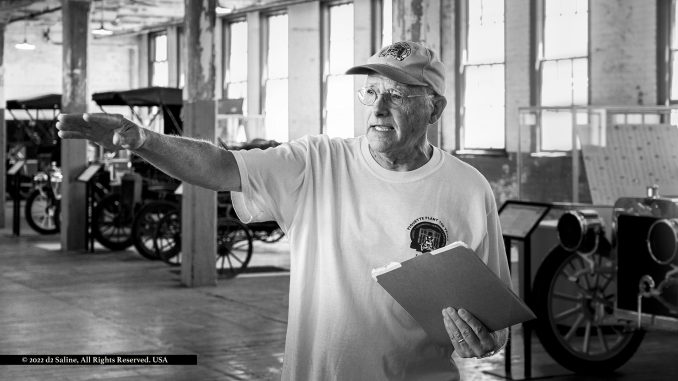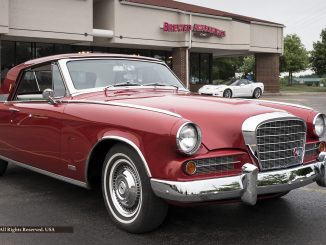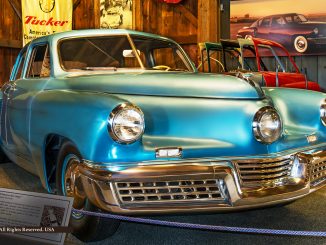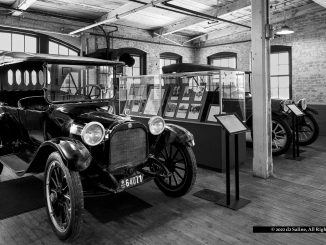
Persuit of historical firsts is frequently fraught with challenges. Challenges inherent in the efforts themselves, as well as challenges to the necessary parameters that invariably must be imposed upon even the most expert of efforts. [1]
Case in point: The pilgrimage yesterday to see one of the earliest Dodge Brothers automobiles, currently housed in Detroit. Organized by and on behalf of Dodge Brothers Club members, this was as much if not more so a story about those innovative brothers themselves, John F and Horace E Dodge. [2-4]
They made an early name for their work with a patented “four-point adjustable ball bearing for bicycles that sealed out much of the grit that caused component wear.” They utilized this in the manufacture of bicycles in partnership with Frederick Samuel Evans, out of their own “small machine shop on Beaubien Street in Detroit in 1900,” according to automotive historian Robert Tate. [5-9]
Later, they would move their shop to a new location at Hastings Street and Monroe employing 200 men ….
“Their first major automotive customer was Ransom E Olds,” Meadow Brook Hall recorded. He “hired them in 1901 to produce 2,000 engines for his new curved-dash Oldsmobile. [9-11]
Olds was pleased enough with their work to add 3,000 transmissions to his order the following year, making the brothers major players in the automotive industry.
At that point, the “world’s first mass produced vehicle,” the Curved Dash Oldsmobile, arguably included some mix of Dodge brothers DNA with that of Ransom E Olds.
And that, then, contributed to the final success of Henry Ford as automaker.
As more than a dozen Dodge Brothers Club members saw yesterday, a tour of the Ford Piquette Avenue Plant museum lead gallery on the second floor introduced what is the only complete public display of “Letter” (or “Alphabet”) cars not under the monikker of its namesake, but with a sense of Oldsmobile, à la 1904 Curved Dash body, “Runabout Model 6C.” [12-15]
Picking up again with this history as recorded by Kurt Ernst for Hemmings: “By 1903, the Dodge brothers had become one of the largest suppliers to the automotive industry, prompting Henry Ford to engage the company in building chassis assemblies (including engines, transmissions and axles) for his early automobiles.
Ford’s scope of scale was large enough that the Dodge brothers soon began to work exclusively for Henry Ford, and when Ford had difficulty paying his suppliers, the Dodge brothers found themselves shareholders in the Ford Motor Company.
Ford Piquette Avenue Plant Trustee Barry Cogan expanded upon this as he lead his special tour yesterday. Pointing to the 1903 Model A, 1904 Model B, 1905 Model C, and 1906 Model F, he laid claim to each as “as much Dodge as it was Ford. [16-27]
It’s also fair to say that what we think of as ‘a model year’ was not the way they strictly thought back then; minor and significant changes and improvements were constantly being made. [28]
Dodge was constantly making improvements to everything they were delivering to Ford for the cars that were being assembled in this [Piquette Avenue Plant] building.
Seven decades later, as much as this approach would brand Allanté a “Cadillac,” as opposed to “Pininfarina,” those early letter-cars might today be colloquially referenced as “Dodge Brothers” makes — had it not been that Ford went on to rank number 22 on the Fortune 500, the Dodge identity buried ever deeper beneath the various new identities of Chrysler parents. [29-31]
The Ford Model F begat K, begat N, and so forth — with John and Horace Dodge intimately involved in each successive iteration. This continued, of course, into their contributions to early Model T production. [32-38]
As noted here at the outset, of course, none of this is as “clear and simple” as “popular history” would have it. A search for earliest examples of cars from that sort of story need not begin any earlier than November 14, 1914, when the first “Dodge Brothers Motor Company” automobile is often said to have rolled off their own assembly line. [39]
And for that, see Part II of this two-part series, scheduled to publish here on Saline Journal tomorrow. [40]
References
- “Problems of History” Brian Doone, Jennifer Llewellyn, and Steve Thompson (May 2019) Alpha History.
- Dodge Brothers Club (home page).
- “John F Dodge: Inducted 1997 (1864-1920)” Automotive Hall of Fame.
- “Horace E Dodge: Inducted 1981 (1868-1920)” Automotive Hall of Fame.
- “Dodge Brothers” Meadow Brook.
- “From ball bearings to big-blocks: AACA Museum celebrates 100 years of Dodge” Kurt Ernst (September 8, 2014) Hemmings.
- “Dodge Brothers Exhibit Receives New Set of Wheels” (August 2017) Meadow Brook.
- “The Evans & Dodge Bicycle 1896-1900” John A McKenty (March 2, 2013) Vintage CCM.
- “Remembering the Famous Dodge Brothers, a Brief History” Robert Tate (March 13, 2019) Motor Cities.
- “1903 Oldsmobile Curved Dash Runabout” GM Heritage Center.
- “1902 Curved Dash Oldsmobile at the Owls Head Transportation Museum” Owls Head Transportation Museum (April 21, 2015) YouTube (14:11 minutes).
- The Ford Piquette Avenue Plant (home page).
- “After 100 Years, ‘Alphabet’ Cars Reunited at Ford Piquette Plant” (November 15, 2018) Ford Performance.
- “Ford Piquette Avenue Plant: 1904 Curved Dash Oldsmobile Body” (2017) Ford Piquette Plant.
- “1904 Curved Dash Oldsmobile Body” (2017) Ford Piquette Avenue Plant.
- “Ford Piquette Avenue Plant: 1903 Ford Model A Tonneau – Larry D Porter Artifacts Trust” (2017) Ford Piquette Plant.
- “1903 Ford Model A Tonneau” (2017) Ford Piquette Avenue Plant.
- “Ford Model A (1903-1904) – Model A ford1903 – Oldest Ford Motor Car in the world” Classic Dude (December 30, 2020) YouTube (3:14 minutes).
- “Ford Piquette Avenue Plant: 1904 Ford Model B Tonneau – Larry D Porter Artifacts Trust” (2017) Ford Piquette Plant.
- “1904 Ford Model B Tonneau” (2017) Ford Piquette Plant.
- “Ford Model B (1904-1906) – Ford’s First Car With Front Engine Design Ever (Ford B Model)” Classics Dude (March 21, 2021) YouTube (2:28 minutes).
- “Ford Piquette Avenue Plant: 1905 Ford Model C Tonneau – Larry D Porter Artifacts Trust” (2017) Ford Piquette Plant.
- “1905 Ford Model C Tonneau” (2017) Ford Piquette Plant.
- “1904 Ford Model C – Ford’s firs car Made in Canada” Classics Dude (February 24, 2021) YouTube (2:25 minutes).
- “Ford Piquette Avenue Plant: 1906 Ford Model F Tonneau – Larry D Porter Artifacts Trust” (2017) Ford Piquette Plant.
- “1906 Ford Model F Touring” (2017) Ford Piquette Plant.
- “Ford Model F (1905) – Was Described As ‘Rich and dark’ Classics Dude” (March 28, 2021) YouTube (2:02 minutes).
- “What is the Make and Model of a Car? Your Ultimate Guide” NADA Guides.
- “Cadillac Allanté | Know This Car” Jalopnik (October 20, 2017) YouTube (3:00 minutes).
- “Dodge History” logansportauto (March 14, 2011) YouTube (13:16 minutes).
- “The Stellantis Era Dawns: FCA Is Dead, Brands Like Chrysler May Not Survive” Alisa Priddle (January 15, 2021) MotorTrend.
- “Before the Model T: Henry Ford’s Letter Cars” (September 4, 2013) The Henry Ford.
- “Ford Piquette Avenue Plant: 1908 Ford Model K 6-40 Roadster – Larry D Porter Artifacts Trust” (2017) Ford Piquette Plant.
- “1908 Ford Model K 6-40 Roadster” (2017) Ford Piquette Plant.
- “Ford Model K (1906-1908) – [Classic Ford Review]” Classics Dude (August 18, 2021) YouTube (3:24 minutes).
- “Ford Piquette Avenue Plant: 1906 Ford Model N Runabout – Larry D Porter Artifacts Trust” (2017) Ford Piquette Plant.
- “1908 Ford Model N Runabout” (2017) Ford Piquette Plant.
- “Ford Model N (1906-1908) – [Clasic Ford Review]” Classics Dude (September 22, 2021) YouTube (3:22 minutes).
- The Dodge Brothers: The Men, the Motor Cars, and the Legacy, Charles K Hyde (2005) Wayne State University Press.
- “Findings from Dodge Brothers Club trip to Detroit this week, connecting with earliest founders-produced car(s): Part II” Dell Deaton (June 25, 2022) Saline Journal.



